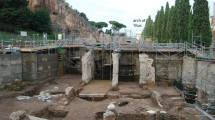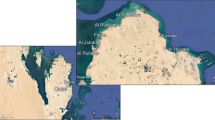Abstract
This paper presents the chemical and isotopic analyses of glass from the first century CE excavated in Dibba (United Arab Emirates). The elemental composition was determined using inductively coupled plasma-optical emission spectrometry (ICP-OES) and micro-X-ray fluorescence (μXRF), as well as the isotopic composition using laser ablation-multi collector-ICP-mass spectrometry (LA-MC-ICP-MS) for Sr and solution MC-ICP-MS for Nd. This study revealed the unique elemental and isotopic composition of this material, matching the local geology and providing a strong argument for a previously unknown production site, possibly local, for this material. Two glass hues are observed in the assemblage (green and amber); both have the same chemical composition. The colour difference is due to differences in the oxidation state of the chromophores whether or not purposefully is unclear. The production of blown glass vessels shows a technology, not yet evidenced before, for this period in this region.



Similar content being viewed by others
References
Andersen SF (2007) The Tylos period burials in Bahrain, volume 1. The glass and pottery vessels. Bahrain, Aarhus University Press, Aarhus
Bhardwaj HC (1979) Aspects of ancient Indian technology. Motilal Banarsidass, Delhi
Brill RH (1999) Chemical analyses of early glasses, vol 1. Corning Museum of Glass, New York
Cox J, Searle M, Pedersen R (1999) The petrogenesis of leucogranitic dykes intruding the northern Semail ophiolite, United Arab Emirates: field relationships, geochemistry and Sr/Nd isotope systematics. Contrib Mineral Petrol 137:267–287
Degryse P, Schneider J (2008) Pliny the elder and Sr–Nd isotopes: tracing the provenance of raw materials for roman glass production. J Archaeol Sci 35:1993–2000
Degryse P, Shortland A (2009) Trace elements in provenancing raw materials for roman glass production. Geol Belg 12:135–143
Degryse P, Schneider J, Lauwers V, Henderson J, Van Daele B, Martens M, Huisman HDJ, De Muynck D, Muchez P (2009) Neodymium and strontium isotopes in the provenance determination of primary natron glass production. In: Degryse P, Henderson J, Hodgins G (eds) Isotopes in vitreous materials. Studies in archaeological sciences. University Press, Leuven, pp 53–72
Dussubieux L, Gratuze B, Blet-Lemarquand M (2010) Mineral soda alumina glass: occurence and meaning. J Archaeol Sci 37:1646–1655
Eremin K, Degryse P, Erb-Satullo N, Ganio M, Greene J, Shortland A, Walton M, Stager L (2011) Amulets and infant burials: glass beads from the Carthage Tophet. Proceedings of the SEM and microanalysis in the study of historical technology, materials and conservation conference, London, UK, 9-10 September 2010
Freestone IC, Leslie KA, Thirlwall M, Gorin-Rosen Y (2003) Strontium isotopes in the investigation of early glass production: byzantine and early islamic glass from the near east. Archaeometry 45:19–32
Ganio M (2013) A ‘true’ Roman glass: evidence for primary production in Italy. PhD Thesis, KU Leuven
Ganio M, Boyen S, Fenn T, Scott R, Vanhoutte S, Gimeno D, Degryse P (2012a) Roman glass across the empire: an elemental and isotopic characterization. J Anal At Spectrom 27:743–753
Ganio M, Boyen S, Brems D, Scott R, Foy D, Latruwe K, Molin G, Silvestri A, Vanhaecke F, Degryse P (2012b) Trade routes across the Mediterranean: a Sr/Nd isotopic investigation on roman colourless glass. Glass Technol: Eur J Glass Sci Technol A 53:217–224
Ganio M, Gulmini M, Latruwe K, Vanhaecke F, Degryse P (2013) Sasanian glass from Veh Ardašīr investigated by strontium and neodymium isotopic analysis. J Archaeol Sci 40:4264–4270
Garzanti E, Andò S, Vezzoli G, Dell’era D (2003) From rifted margins to foreland and basins: investigating provenance and sediment dispersal across desert Arabia (Oman, U.A.E.) J Sediment Res 73:572–588
Govind V (1970) Some aspects of glass manufacturing in ancient India. Indian journal of the. Hist Sci 5(2):281–308
Henderson J, Evans J, Barkoudah Y (2009) The roots of provenance: glass, plants and isotopes in the islamic middle east. Antiquity 83:414–429
Jasim SA (1999) The excavation of a camel cemetery at Mleiha, Sharjah, U.A.E. Arab Archaeol Epigr 10:69–101
Jasim SA (2006) Trade centres and commercial routes in the Arabian gulf: post-Hellenistic discoveries at Dibba, Sharjah, United Arab Emirates. Arab Archaeol Epigr 17:214–237
Jasim SA, Yousif E (2014) Dibba: an ancient port on the Gulf of Oman in the early roman era. Arab Archaeol Epigr 25:50–79
Kanungo AK, Brill RH (2009) Kopia, India’s first glassmaking site: dating and chemical analysis. J Glass Stud 51:11–24
Kutterer A, Uerpmann HP (2017) Neolithic nomadism in south-east Arabia — strontium and oxygen isotope ratios in human tooth enamel from al-Buhais 18 and umm al-Quwain 2 in the emirates of Sharjah and umm al-Quwain (UAE). Arab Archaeol Epigr 28:75–89
Mirti P, Pace M, Negro Ponzi MM, Aceto M (2008) ICP-MS analysis of glass fragments of Parthian and Sasanian epoch from Seleucia and Veh Ardašir (Central Iraq). Archaeometry 50:429–450
Mirti P, Pace M, Malandrino M, Ponzi MN (2009) Sasanian glass from Veh Ardašir: new evidences by ICP-MS analysis. J Archaeol Sci 36:1061–1069
Overlaet B, Macdonald M, Stein P (2016) An Aramaic-Hasaitic bilingual inscription from a monumental tomb at Mleiha, Sharjah, U.A.E. Arab Archaeol Epigr 27:127–142
Paynter S, Jackson CM (2017) Mellow yellow: an experiment in amber. J Archaeol Sci Rep. https://doi.org/10.1016/j.jasrep.2017.11.038
Sayre AV (1964) Some ancient glass specimens with compositions of particular archaeological significance, Report, Brookhaven National Laboratory, Upton, New York
Sayre EV, Smith RW (1961) Compositional categories of ancient glass. Science 133:1824–1826
Seland EH (2014) Archaeology of trade in the western Indian Ocean, 300 BC–AD 700. J Archaeol Res 22:367–402
Shortland A, Schroeder H (2009) Analysis of first millennium BC glass vessels and beads from the Pichvnari necropolis, Georgia. Archaeometry 51:947–965
Van Ham-Meert A, Chernonozhkin S, Van Malderen SJM, Van Acker T, Vanhaecke F, Degryse P (2018) Assessment of nanosecond laser ablation multi-collector-inductively coupled plasma-mass spectrometry for Pb and Sr isotopic analysis of archaeological glass: mass bias correction strategies and results for corning glass reference materials. Geostand Geoanal Res. https://doi.org/10.1111/ggr.12202
Whitehouse D (1998) Excavations at ed-Dur, umm al Qaiwain, United Arab Emirates. Vol. I – The Glass Vessels, Leuven
Whitehouse D (2000) Ancient glass from ed-Dur (umm al-Qaiwain, U.A.E.) 2. Glass excavated by the Danish expedition. Arab Archaeol Epigr 11:87–128
Worrel S, Price J (2001) The glass from Kush, Ra’s al-Khaimah, U.A.E. In: Potts P, Naboodah DT, Hellyer HA (eds) Archaeology of the United Arab Emirates. trident press ltd, London, pp 248–252
Acknowledgements
The authors are thankful to the Emirate of Sharjah for providing the samples for analysis. The authors are also thankful for the helpful comments of the reviewers which have contributed to the coherence and thoroughness of the paper.
Funding
Alicia Van Ham-Meert is funded on a project from the Flemish research fund (FWO) with number G.0C43.15. Philippe Claeys is thankful to Hercules for funding the purchase of the μ-XRF.
Author information
Authors and Affiliations
Corresponding author
Electronic supplementary material
ESM 1
(XLSX 39.3 kb)
Rights and permissions
About this article
Cite this article
Van Ham-Meert, A., Claeys, P., Jasim, S. et al. Plant ash glass from first century CE Dibba, U.A.E. Archaeol Anthropol Sci 11, 1431–1441 (2019). https://doi.org/10.1007/s12520-018-0611-0
Received:
Accepted:
Published:
Issue Date:
DOI: https://doi.org/10.1007/s12520-018-0611-0




